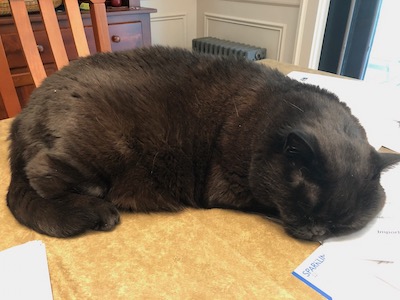Post-COVID-19 Brain Fog: A Portrait in Data
Tagged:CatBlogging
/
COVID
/
Sadness
/
SomebodyAskedMe
Somebody asked me whether all my whining about post-COVID-19 brain fog was real. Yes, it is.
A data portrait of an elusive condition
Questions like this (“are you sure you’re really sick?”) are frustrating and not a little insulting.
There have been lots of diseases without obvious causes and ineffective treatments for which the sufferers have been accused of malingering. The problem is particularly acute for women: getting properly diagnosed with Chronic Fatigue Syndrome is exceptionally difficult, not to mention the historical abusive diagnoses like “hysteria” that women have had to face. Mental health disorders, such as depression and anxiety, face similar public shaming, independent of gender.
So don’t be surprised if you try this on someone and get an angry reaction. COVID-19 brain fog is real (even if it’s not as drastic as the Long COVID-19 experienced by some unlucky souls).
As we’ve cited before on this Crummy Little Blog That Nobody Reads (CLBTNR), post-COVID-19 brain fog appears to have a median recovery time of 7-9 months. [1] [2] It’s now been 9 months since I had a month-long long disability from COVID-19, so I’m in the zone. But remember: “median time to recovery” means 50% of people take longer than that.
Now, there’s plenty of evidence in the scientific literature to back this up, and even explainers for the public to convince us of this. I’m not just whining about my personal case (though that is, admittedly, one thing I’m doing).
 Here’s a picture (click to embiggen) of some data that brought home to me the raw reality of
my current mild-to-moderate cognitive impairment:
Here’s a picture (click to embiggen) of some data that brought home to me the raw reality of
my current mild-to-moderate cognitive impairment:
- We’re looking at the commit frequency to GitHub, where this CLBTNR’s data is stored. For non-software types, that roughly means how often I’ve uploaded something to add to the blog, or changed something already there.
- Time flows from left to right, over the trailing year from today. Each column is a week. Each little square is a day.
- The color indicates an activity level: dark green means lots of commits, light green just a few, and gray nothing at all.
- There are 1489 commits shown here in the trailing 1-year data.
Can you spot the rather obvious pattern?
- I got COVID-19 in August. Immediately after that, there are no more dark green squares of high-activity days.
- The post-COVID-19 brain fog set in, along with attendant depression, in November. Immediately after that starts the gray desert of inactivity, where I was not capable of much at all beyond keeping myself fed and bathed.
It’s terrifying.
A month ago, I was trying to recall the Wigner-Eckart theorem. To tell the truth, it was just an exercise in nostalgia: that theorem was one of the most beautiful, gasp-inducing things I learned my first year in grad school. It’s been a little gem of a memory that I bring out to remind myself I’d learned about a good thing.
But… I couldn’t remember it! I had to go look it up, upon which it all came back, of course. But it terrified me that this precious memory was, for now, faded like a wilted flower under the cruel rule of brain fog. [3]
At about the same time, I was at a dinner party (one of the first post-pandemic dinner parties I’ve attended). I was momentarily scared I was having a stroke, because I could not understand the table conversations. It turned out to be because there were multiple conversations happening, and it just overwhelmed me. Usually, I can follow 2, sometimes 3, threads of conversation simultaneously.
Now, if there’s more than one conversation, the number of threads I can follow is 0.
The Weekend Conclusion
Ok, I have to admit: it might be getting better… slowly, and in a minuscule fashion.
That might be due to brain fog recovery. Or it might be due to the rather high dose of anti-depressant in my system. Or might be spring. Or it might be my hope luring me into self-deception.
The Weekend Publisher, shown here, counsels relaxation. But that’s pretty much what he always counsels, when he’s not glaring at the local fauna, complaining about my sloth with dispensing the cat food, or complaining in French about ChatGPT. (He complains a lot, but seems overall content with his life. He doesn’t understand why I’m so anxious. Sometimes, I don’t either.)
What I do know is that brain fog is real. And kinda scary.
Notes & References
1: H Davis, et al., “Characterizing long COVID in an international cohort: 7 months of symptoms and their impact”, The Lancet, 2021-Jul1-15. DOI: 10.1016/j.eclinm.2021.101019.
See § 3.3.1: 55.5% (CL: 52.5% - 58.8%) of patients still experienced “brain fog” in month 7, so that’s close enough for me to the median time to recovery. So, to my mind I say: see you in 2023-Feb. It’s very frustrating to hear people say “COVID’s over, man!” when the consequences to me personally are somewhat high. ↩
2: C Callan, et al., “‘I can’t cope with multiple inputs’: a qualitative study of the lived experience of ‘brain fog’ after COVID-19”, BMJ Open, 2022-Feb-11. DOI: 10.1136/bmjopen-2021-056366. ↩
3: We nerds have a sense of beauty, too. Mock if you like, but you’ll just be self-identifying as a barbarian. ↩


Gestae Commentaria
Comments for this post are closed pending repair of the comment system, but the Email/Twitter/Mastodon icons at page-top always work.